Rosario, Argentina
Rosario (Argentina) is the fourth city of Latin America by the significance of Lithuanian heritage. Only Sao Paulo, Buenos Aires, and Montevideo have more.

Traditional Lithuanian cross in front of the Rosario Lithuanain church and a Lithuanian coat of arms on the church facade
Rosario St.Casimir Lithuanian church and Margis street
St. Casimir Lithuanian church is the largest Lithuanian building of Rosario. It is rather simple in its design: the interior is mostly white, without grand stained-glass windows and murals. Lithuanian spirit is accentuated by details: a Lithuanian coat of arms on the façade (next to the Argentine coat of arms) and the image of St. Casimir (the patron saint of Lithuania); a traditional Lithuanian cross in front of the church (Lithuanian wooden crosses are UNESCO world heritage); inside the church, on top of the altar, a unique symbol that joins cross and Columns of Gediminas is depicted. Also, the church interior hosts three memorial plaques to Lithuanian priests – the founders of the church Jeronimas Jakaitis and Kazimieras Vengras, as well as Pranciškus Brazys who later became a bishop for Lithuanians abroad.
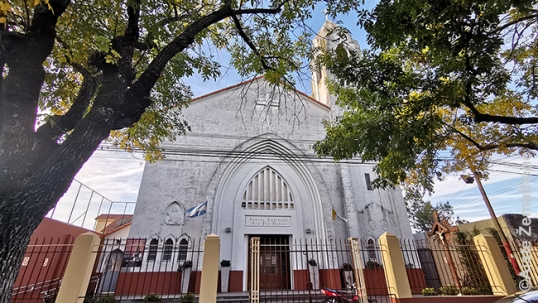
Rosario Lithuanian church

The interior of the Rosario Lithuanian church

Columns of Gediminas over the image of the Christ in the front of the church
The church has been constructed in 1953-1954. For as much as 35 years (1957-1963 and 1967-1996) Juozas Margis served as its pastor (in Argentina, he was known as Jose Margis). This priest became famous all over Argentina (beyond the Lithuanian community) for the exorcisms he performed. Near the church a street has been named after Margis. Akin to many Lithuanian priests of South America, Margis was not born in Argentina – he was born in the USA, however, he decided to serve the Lithuanian-Argentines. Margis is interred in the St. Casimir church – the side altar under an image of Divine Mercy (the original image of Divine Mercy is in Vilnius, Lithuania). The church also served as a hub of an official Lithuanian community for both the religious an patriotic Lithuanians, they did their secular ethnic activities on the parish grounds as well.
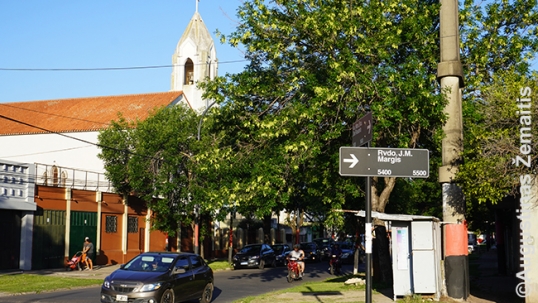
Margis Street with the Lithuanian church in the background
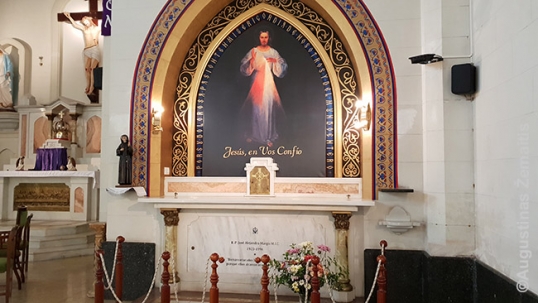
Priest Margis grave under an image of Divine Mercy
After Margis’s death, the St. Casimir Lithuanian church of Rosario no longer had Lithuanian priests nor Masses, however, it is still served by Marian Fathers. This order has been saved from extinction by Lithuanian priest Jurgis Matulaitis who was the only active member of the order at one time. It was the Lithuanian Marian Fathers who established the St. Casimir parish of Rosario.
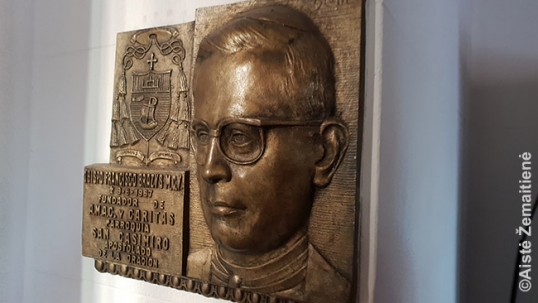
Bishop Brazys commemorative plaque in the church
In 1962-1964, a Republic of Lithuania school has been opened near the church, expanded in 1968, to be joined by St. Casimir kindergarten in 1985 and Jose Margis school in 2008. The buildings are even humbler. St. Casimir church served as a community center, therefore, instead of investing in its lavishness, the community decided to build more buildings that would serve the community. The school was never exactly Lithuanian as such (in Argentina, all schools have the same program), however, it was attended by the kids of the Lithuanians who were parish members. The teachers were Lithuanian St. Casimir Sisters from a Lithuanian-American order of nuns. The school hall also served as a venue for Lithuanian folk dances. Parts of school still has Lithuanian names such as Patio Antonio Švedas, St. Casimir garden and Salon Padre Jose (named after Margis).
At the present time, the parish has mostly non-Lithuanian members. It is quite far from the downtown so Lithuanians who moved to other districts typically joined the parishes there.
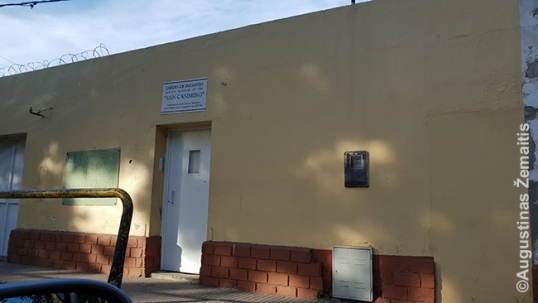
St. Casimir kindergarten near the church
Rosario Lithuanian Social Club
The building of Rosario Lithuanian club has been built around the era of First World War. It was acquired by Lithuanians in 1947. Most Lithuanians immigrated to Rosario (just like to other cities of South America) around the years 1925-1930, therefore, by 1947 the community was already established enough to have its own premises.
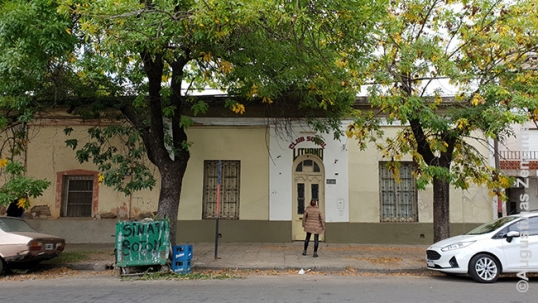
Rosario Lithuanian club
In 1972 the club was expanded with an annex that includes a large event hall.
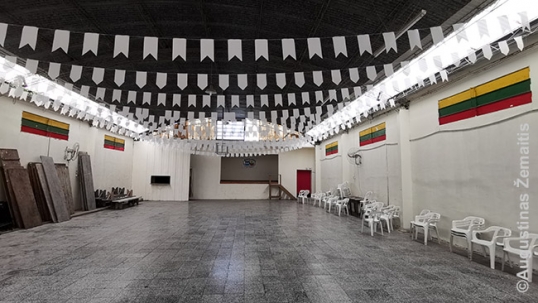
Rosario Lithuanian club hall
In 2009, to commemorate the 1000 year anniversary of the first mention of name “Lithuania” in written text, the Lithuanian government funded a restoration of the club building, where a new smaller hall dedicated to the millennium of Lithuania was opened. However, after the money was exchanged into Argentine peso, the peso deprecated and therefore inflation precluded from completing the project. Thus the second floor of the club, originally intended to be a small guest house for visiting Lithuanian bands and artists, was not completed.
Club corridors are adorned by old pictures of the club and commemorative plaques that remind of the key events in the club history.
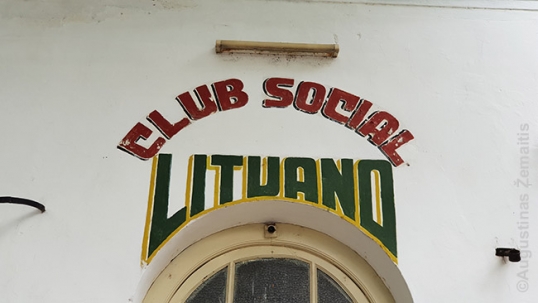
The symbol of Rosario Lithuanian club
The club is open on Saturdays and Sundays. Four times a year bigger festivals are held (for example, the anniversary of the club establishment festival in May). These attract some 200 people. The club has ~120 members.
Historically, the club was associated more with the leftists, although it was never exclusively socialist. Still, some of the more religious or patriotic members of Lithuanian parish avoided the club, while the more leftist members of club avoided the Lithuanian church. However, more moderate Lithuanians participated in both the church and the club.
Lithuania Street of Rosario and other sistes
The Lithuanian community of Rosario achieved that a street not too far from the club was renamed Lituania street in 1962. In the center of the street, near the monument to Eva Peron, there is a commemorative plaque indicating it was gifted by the Lithuanian community to “Rosario, the city of the flag”. The plaque depicts the coat of arms of Lithuania as well as the Flag memorial that is located in the center of Rosario.
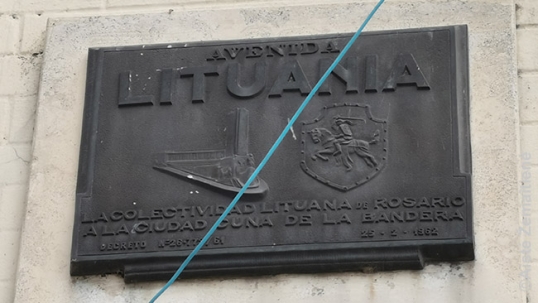
Lituania street commemorative plaque in Rosario
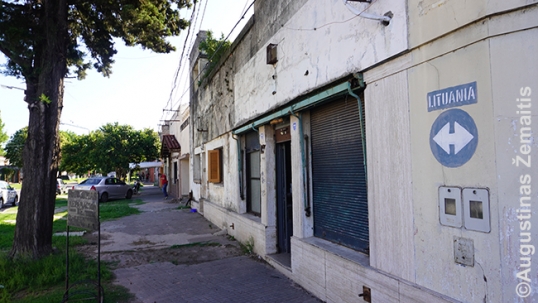
Lituania Street
Rosario is known as “the city of the flag” because it was the site where the Argentine flag was first raised. On the exact spot, the Flag memorial was built. In front of that memorial, other flags are also respected. Its interior houses a gallery of American flags whereas the flags of the countries that have consulates in Rosario are raised in front of the memorial during the national holidays of these countries.
Every year on February 16th the Lithuanian flag is also raised there while the Lithuanian national anthem is playing.

Flag memorial of Rosario
Rosario still has surviving slaughterhouses which have originally attracted Lithuanians to this city that stands in the center of the Argentine meat growing area. One of them is the Swift slaughterhouse.

Swift slaughterhouse in Rosario
In the southern part of Rosario a second Lithuanian club once operated known as Aušros žvaigždė (Star of dawn). It began as a small library of Lithuanian books acquired from Chicago back in 1907, known as Krivių Krivaičio. However, as some Lithuanians departed Rosario area ~1911 the activities dwindled. The organization was named and restored in 1918 and agreed to build a clubhouse in 1928. It had 150 members, a number which declined to 70 in the 1960s. ~1970 the building was sold and replaced by a library.




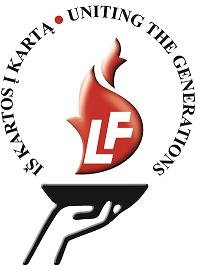

Leave a comment